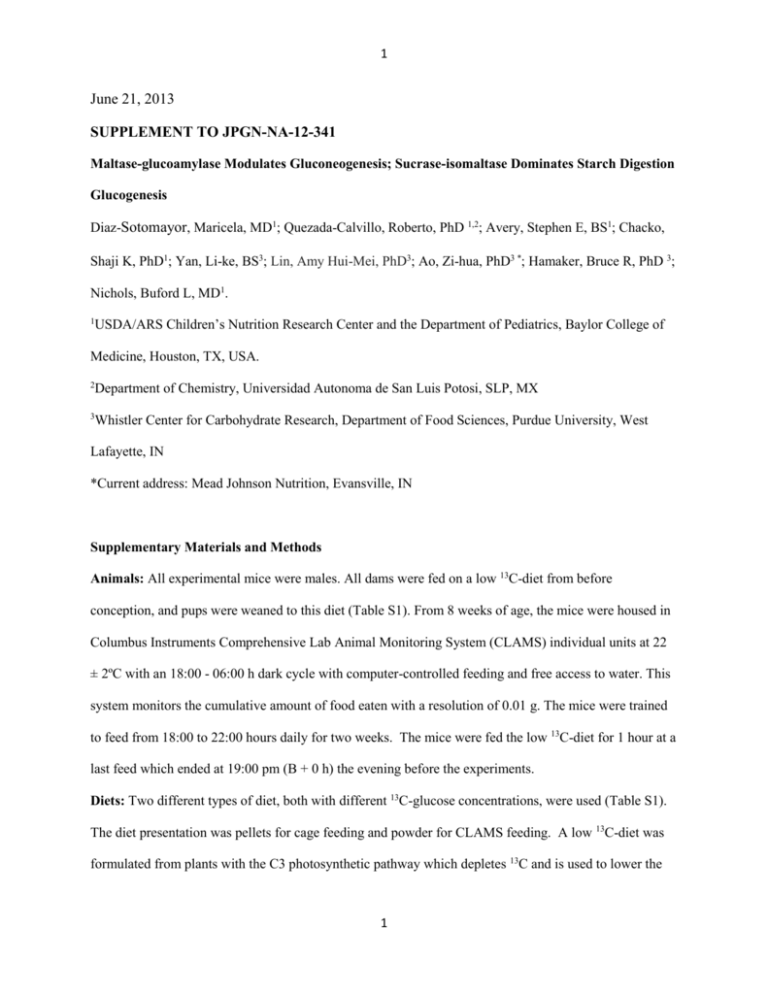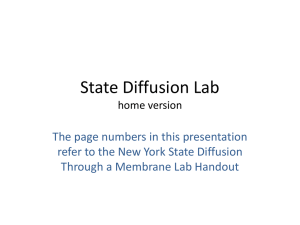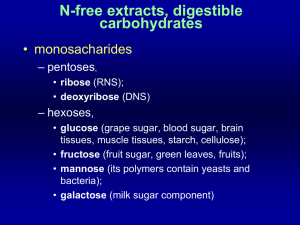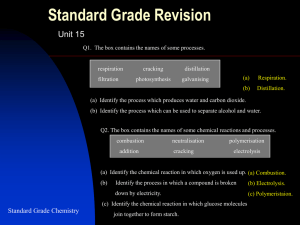h2o analytical
advertisement

1 June 21, 2013 SUPPLEMENT TO JPGN-NA-12-341 Maltase-glucoamylase Modulates Gluconeogenesis; Sucrase-isomaltase Dominates Starch Digestion Glucogenesis Diaz-Sotomayor, Maricela, MD1; Quezada-Calvillo, Roberto, PhD 1,2; Avery, Stephen E, BS1; Chacko, Shaji K, PhD1; Yan, Li-ke, BS3; Lin, Amy Hui-Mei, PhD3; Ao, Zi-hua, PhD3 *; Hamaker, Bruce R, PhD 3; Nichols, Buford L, MD1. USDA/ARS Children’s Nutrition Research Center and the Department of Pediatrics, Baylor College of 1 Medicine, Houston, TX, USA. 2 Department of Chemistry, Universidad Autonoma de San Luis Potosi, SLP, MX 3 Whistler Center for Carbohydrate Research, Department of Food Sciences, Purdue University, West Lafayette, IN *Current address: Mead Johnson Nutrition, Evansville, IN Supplementary Materials and Methods Animals: All experimental mice were males. All dams were fed on a low 13C-diet from before conception, and pups were weaned to this diet (Table S1). From 8 weeks of age, the mice were housed in Columbus Instruments Comprehensive Lab Animal Monitoring System (CLAMS) individual units at 22 ± 2ºC with an 18:00 - 06:00 h dark cycle with computer-controlled feeding and free access to water. This system monitors the cumulative amount of food eaten with a resolution of 0.01 g. The mice were trained to feed from 18:00 to 22:00 hours daily for two weeks. The mice were fed the low 13C-diet for 1 hour at a last feed which ended at 19:00 pm (B + 0 h) the evening before the experiments. Diets: Two different types of diet, both with different 13C-glucose concentrations, were used (Table S1). The diet presentation was pellets for cage feeding and powder for CLAMS feeding. A low 13C-diet was formulated from plants with the C3 photosynthetic pathway which depletes 13C and is used to lower the 1 2 baseline mol percent enrichment (MPE). A high 13C-diet was formulated from C4 photosynthetic pathway plants (S1) and used for the starch digestion test. The C3 diet with 53% rice starch and beet sugar (Harlan TD 6089) had a 13C-glucose enrichment of 1.76 ×10-3 ± 4.58 ×10-3 MPE. The C4 high 13C-diet used for testing was 53% maize starch (Harlan TD 1629), which had a 13C-glucose enrichment of 104.8 ×10-3 ± 2.56 ×10-3 MPE. To characterize the null mouse residual Si activity on a variety of substrates, granular starch substrates were hydrolyzed in vitro with AMY for 0-180 min followed by incubation with Mgam null mouse small bowel lysates, and GG was analyzed by the methods used in a previously reported human GG study (14.15, S2). Measured food intakes: Mouse food intake was regulated and monitored by computer in individual cages of the CLAMS unit. The animals were first adapted to a 4 h feeding cycle (18:00-22:00) for more than 7 days by regulating availability of the low 13C-diet. Adaptation to this feeding pattern became stable and was equivalent to the ad libitum pattern by the fourth day (data not shown). Blood analysis: Total blood glucose was measured by a glucometer (Freestyle Blood Glucose Meter [Cat. #11001], TheraSense, Alameda, CA) and blood was spotted on filter paper for mass analysis. Blood was obtained by tail nicking at B + 5, 12, 12.5, 13, 14, and 16 h, and by decapitation at 14 or 16 h. The terminal blood was collected by flow from the carotids into chilled fluoride/EDA tubes and held at 4ºC until centrifuged. Plasma was removed and stored at -70ºC for analysis of total glucose, 2H2O, and 13C- or 2 H-glucose (S3). Small intestinal carbohydrate content: After euthanasia, the intact small intestine was removed and frozen in liquid nitrogen and stored at -70°C. The frozen small intestine was weighed, placed in 80% (v/v) ethanol, and homogenized. A 0.1 mL aliquot was removed for protein determination by the Bradford method (S4). The remaining homogenate was then incubated in a water bath for 30 min at 80°C. After cooling, a supernatant was collected by centrifugation and 0.5 mL of supernatant was added to deionized water to achieve 10% (v/v) ethanol. Free glucose was determined directly in the supernatant using glucose oxidase/peroxidase (GOPOD, Megazyme International, Ireland) reagent. Soluble oligosaccharides (including glucose) were determined by diluting 1 mL of the same supernatant with 7 mL of 50 mmol/L 2 3 sodium acetate buffer, pH 4.5, to achieve 10% (v/v) ethanol, and 5 units of AMG were added. Enzymatic reaction was performed at 50°C for 30 min, and the liberated glucose was determined as above. The oligosaccharide fraction was corrected for free glucose content. Total residual starch was defined as the sum of glucose obtained from the hydrolysis of the centrifuged precipitate. The pellet was suspended in 0.2 mL of 80% (v/v) ethanol, and 2 mL of 90% dimethyl sulfoxide (DMSO) added. The DMSO mixture was heated in a boiling water bath for 20 min with stirring to disperse the starch. Starch and oligosaccharides from the dispersion were hydrolyzed to glucose by the AMG/AMY method (Megazyme total starch assay kit, Ireland) and liberated glucose was quantified as above. The carbohydrate results were expressed as total content. Calculations: Fractional α-glucogenesis (fGG) = rate of increase in 13C-enriched blood glucose at B + 12-14 h = starch derived 13C-glucose content × starch content × food ingested (S1) Where the blood glucose (MPE), food ingested (g), and starch 13C-glucose MPE content were all analyzed values. Digestion % at steady state = blood glucose 13C-enrichment (MPE) at B = 14-16 h/13C-content of polymeric glucose in maize starch ×100 (S2) Where blood glucose enrichment (MPE) and the high 13C-diet polymeric 13C-glucose content of maize starch is 3.6 x 10-5 MPE /M glucose (Table S1). All MPE and intakes are analytical values. Total absorbed glucose/min = GG = Δ blood MPE ×3.6 ×10-5 MPE/M glucose × blood glucose space of 12% volume/body wt., g/min (S3) Where the body weight is measured and glucose compartment is assumed 12% of body weight (S5). Average (M+1)d = (M+1)(m/z 169) /6 (S4) Where (M+1)d(m/z 169) is the M+1 analytical value of 2H-enrichment of glucose measured using m/z 170/169 and “6” is the number of 2H labeling sites on the m/z 169 fragment of glucose (6). 3 4 Fractional gluconeogenesis (fGNG %) = average (M+1)d/EH2O (S5) Where EH2O is the analytical value for steady state 2H-enrichment in body water (S3). Fractional glycogenolysis (fGL) = 1- (fGG + fGNG). (S6) Where fGG and fGNG are calculated values. Statistical Analysis: All means are reported as ± standard deviation. Significance is identified if p < 0.05. The t-test was used to determine significance between groups; when testing between B + timed periods, the paired t-test was used. Regression analysis tested linear and quadratic Eqs and reported the R2 of the fit. Statistical tests were performed using software Minitab (State College, PA) and SAS/STAT (Cary, NC). SUPPLEMENTARY RESULTS: Dietary Characterization: The diets used in these experiments were characterized by in vitro digestion with AMY and AMG enzyme treatments (6). Total starch in the diet was measured by AMY/AMG enzyme hydrolysis, and the digestibility of starch to free glucose after 20 minutes was measured with AMY/AMG and referred to as rapidly digested starch. After 120 minutes, any undigested residual starch was referred to as resistant starch (6). These results are reported in Table S1. The MPE of the free glucose produced in these assays is also shown in Table S1. The difference of MPE between the rice, beet sugar (TD 6089) and the maize diet (TD 1629) was 103.04 ×10-3 MPE (95% CI: 108.91, 97.17 ×10-3; p = 0.000). All non-starch components of the two diets were identical (2). We converted the quantity of 13Cstarch digested to glucose and absorbed into the blood stream (Table S1) using the glucose enrichment ratio of 3.6 ×10-5 MPE /M of ingested starch glucose to calculate a (fGG) from fed starch (see Eq 1 above). At 10 weeks of age, fasting blood glucose MPE was not significantly different from the MPE of the low 13C-diet. Fasting blood MPE = 4.5 ± 10.6 ×10-3 vs. low 13C-diet MPE = 1.76 ± 4.56 ×10-3 (95% CI: -5.78, 11.35 ×10-3, p = 0.492, df = 12). Therefore, the MPE of the low 13C-diet, which was essentially zero, was set as the analytical reference for the blood MPE enrichments after test feeding of the high 13Cdiet diet. The in vitro digestion of the test normal maize starch by null mouse small bowel lysates was compared with a variety of other starches as a function of time of AMY hydrolysis. Three forms of maize 4 5 had the fastest early phase (20 min) and highest GG at 120 min. Potato, tapioca, rice and waxy maize diverged at 20 min and had lower GG at 120 min. Glycogen, from an animal source, had the lowest GG at all the time points (1,14). SUPPLEMENTARY REFERENCES S1. Schoeller DA, Klein PD, Watkins JB, et al. 13C abundances of nutrients and the effect of variations in 13C isotopic abundances of test meals formulated for 13CO2 breath tests. Am J Clin Nutr 1980;33:2375-85. S2. Ao Z, Quezada-Calvillo R, Sim L, et al. Evidence of native starch degradation with human small intestinal maltase-glucoamylase (recombinant). FEBS Lett 2007;581:2381-8. S3. Chacko SK, Sunehag AL, Sharma S, et al. Measurement of gluconeogenesis using glucose fragments and mass spectrometry after ingestion of deuterium oxide. J Appl Physiol 2009;104:944–951. S4. Kruger NJ. The Bradford method for protein quantitation. Methods Mol Biol 1994;32:9-15. S5. Youn JH, Kim JK, Steil GM. Assessment of extracellular glucose distribution and glucose transport activity in conscious rats. Am J Physiol 1995;268:E712-21. S6. Englyst KN, Englyst HN, Hudson GJ, et al. Rapidly available glucose in foods: an in vitro measurement that reflects the glycemic response. Am J Clin Nutr 1999;69:448-54. 5 6 Supplementary Table S1. Contents of rapidly digestible, slowly digestible, and resistant starches in experimental diets (Triplicate analyses) Experimental Diet Rice starch and beet sugar diet (TD 06089) Rapidly digestible starch*‡ 20 min (%) Slowly digestible starch*‡ 120 min (%) 53.4 ± 3.8 44.0 ± 2.0 53% Corn starch diet (TD 01629) 74.0 ± 4.8 26.9 ± 5.4 (288 M glucose/mg starch) 213 77 Enrichment of TD 01629 starch 3.6 10-5/M bound glucose † 0.027 0.010 * Analyzed using the Englyst assay (S6) † Analyzed using total starch analysis kit from Megazyme (AMG/AMY method) ‡13 C-glucose enrichment of ingested starch = 0.10304 MPE 6 Resistant starch*‡ Total starch†‡ > 120 min (%) (%, dwb) 2.6 24.2 ± 0.3 -0.9 0 51.8 ± 0.6 288 0 0.036 7 SUPPLEMENTARY FIGURE LEGEND: Figure S1. Diagrams of mouse ad libitum and ad limitum experiments. Null and WT mice were ad libitum fed at 12 hours after the last feeding (B +12 h) with euthanasia at B +16 h. Null and WT mice were ad limitum fed at B +12 h with euthanasia at B +14 h. See supplemental text for details on diets, feeding, food intakes, and blood and tissue sampling and analyses. 7








